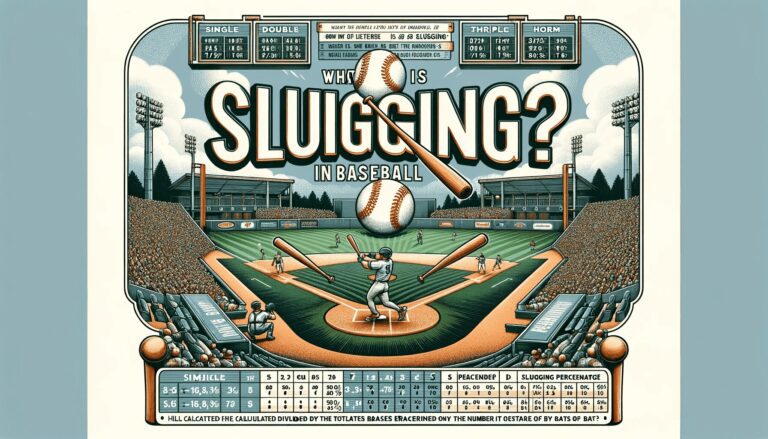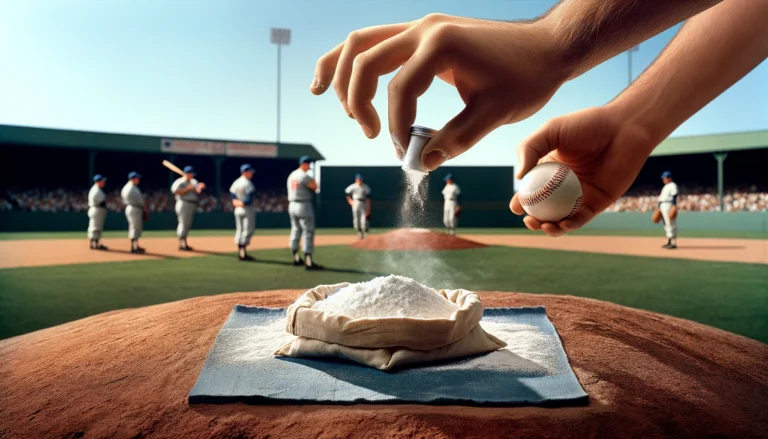What Does 6 4 3 Mean in Baseball?
In baseball, “6-4-3” refers to a double play executed by the fielding team. The numbers represent the positions of the players involved in the play: the first baseman (6), the second baseman (4), and the shortstop (3).
This sequence indicates that the ball was fielded by the second baseman, who then threw it to the shortstop covering second base for the force out, and finally, the shortstop threw the ball to the first baseman to complete the double play.
In this article, we’ll explain the simple yet essential meaning of “6-4-3” and other common number combinations used in baseball scoring.
Key Takeaways
- The ‘6 4 3’ double play is a fundamental defensive strategy in baseball that requires seamless coordination between the shortstop, second baseman, and first baseman.
- Proper footwork, positioning, and communication are crucial for infielders to execute this play efficiently and minimize the risk of errors.
- Practicing specific drills can enhance the quickness and coordination of players, leading to more effective and consistent double plays.
- Infielders must be adept at overcoming common challenges such as hard slides, bad hops, and pressure situations to maintain their defensive prowess.
- Historical analysis of ‘6 4 3’ double plays provides insight into the evolution of the game and the legendary players and teams that have perfected this craft.
Understanding the Basics of the Infield Double Play

Defining the ‘6 4 3’ Double Play
In baseball, the ‘6 4 3’ double play is a sequence where the shortstop (6), second baseman (4), and first baseman (3) work together to record two outs in quick succession.
This maneuver is one out of the most efficient methods to shift the game’s momentum in favor of the defensive team.
The process typically begins with ground ball hit the shortstop fielding a ground ball and throwing it to the second baseman, who is positioned at second base.
The second baseman then quickly pivots and throws the ball to the first baseman, completing the double play.
Here’s a breakdown of the steps:
- Shortstop fields the ground ball.
- Shortstop throws to the second baseman at second base.
- Second baseman pivots and throws to the first baseman.
The ‘6 4 3’ double play requires precise timing, coordination, and skill from all involved players.
It’s a fundamental play that teams practice regularly, as it can be a game-changer in tight situations.
Roles of the Shortstop, Second Baseman, and First Baseman
In the ‘6 4 3’ double play, each infielder has a distinct role that requires precision and teamwork.
The Shortstop, the center fielder positioned between second and third base, is often seen as the linchpin of this defensive maneuver.
They must quickly in center field to the ball and deliver an accurate throw to the second baseman.
- The Second Baseman receives the shortstop’s throw while covering second base. Their primary task is to touch the base for the force out and then pivot to make the throw to first base.
- The First Baseman completes the play by catching the second baseman’s throw. It’s crucial for the first baseman to maintain foot contact with the base to record the out while being prepared to stretch or scoop to catch off-target throws.
The Importance of Footwork and Positioning
In the realm of infield defense, footwork and positioning are the cornerstones that enable a smooth ‘6 4 3’ double play.
Proper footwork ensures that infielders can move quickly to the ball, which is essential for starting the double play efficiently.
Positioning, on the other hand, involves being in the right place at the right time to receive the ball and the right field to make the necessary plays.
- First, infielders must focus on the fundamentals of moving quickly to the ball. This involves short, rapid steps that allow for quick adjustments in any direction.
- Setting feet properly for the throw is another critical aspect. Infielders should align their feet with their target to ensure a strong and accurate throw.
- Lastly, the importance of catching the ball securely cannot be overstressed. A clean catch is the first step in a successful double play sequence.
By mastering these elements, infielders can significantly reduce the time it takes to turn two, making the ‘6 4 3’ double play a formidable weapon in their defensive arsenal.
Read Also: What Does K Mean in Baseball
The Mechanics of Executing a ‘6 4 3’ Double Play

Fielding the Ball: Techniques and Best Practices
The success of a ‘6 4 3’ double play begins the moment the ball to left field is hit. Infielders must be adept at quickly reacting to ground balls, ensuring they field the ball cleanly and efficiently.
Proper body positioning is crucial; players should approach the ball with their gloves low to the ground and their bodies squared to the target. This stance allows for a smooth transition from catching fly ball to throwing.
Once the ball is in the player hits glove, the infielder’s focus shifts to making an accurate throw. It’s essential to have a firm grip on the ball and to align the body with the intended recipient of the throw.
A quick transfer from glove to throwing hand can shave precious seconds off the play. Infielders often practice drills like the Double Play Drill and the Quick Hands Drill to hone these skills.
Consistent practice and repetition of these techniques are key to mastering the art of fielding for double plays.
Each infielder must also be aware of their role in the sequence, anticipating the ball’s trajectory and the runners’ positions to execute the play flawlessly.
The Shortstop’s Pivot: A Critical Component
In this example of the ‘6 4 3’ double play, the shortstop’s pivot is where the magic happens. This maneuver is the linchpin that connects the smooth transfer of the ball from glove to hand to the second baseman.
It requires not only agility and precision but also an acute awareness of the runner’s position.
The pivot can be broken down into several key steps:
- Fielding the ball while moving towards second base.
- Touching the base with the right foot for the force out.
- Rotating the body while transferring the ball to the throwing hand.
- Making a strong, accurate throw to first base to complete the double play.
Each step must be executed with a rhythm that comes from hours of practice. The shortstop must also be prepared to adjust the pivot in response to the speed of the ball and the base runner’s approach.
A well-executed pivot not only secures an out but also protects the shortstop from potential slides by the runner.
The Second Baseman’s Role and Responsibilities
In the ‘6 4 3’ double play, the second baseman plays a pivotal role that requires precision and agility.
After the shortstop fields the ball and makes the initial throw, the catcher and second baseman must be adept at both receiving the ball and making a quick, accurate throw to first base.
- Positioning is crucial; the second baseman must align themselves correctly to both catch the shortstop’s throw and pivot towards first base.
- The player must also be skilled at tagging the base to force out the runner coming from first.
- After securing the out, the second baseman must execute a strong and precise throw to complete the double play at first base.
The second baseman’s responsibilities also extend to situational awareness, such as knowing the speed of the runners and the number of outs, which can influence the decision-making process during the play.
Effective communication with the shortstop and first baseman is essential to ensure a seamless execution of the ‘6 4 3’ double play.
The Throw to First: Timing and Accuracy
The culmination of the ‘6 4 3’ double play is the throw to first base, where precision meets urgency.
The throw must be both swift and accurate, ensuring that the ball reaches the first baseman’s glove before the runner does.
This critical moment can be the difference between an inning-ending play and a missed opportunity.
- The shortstop must have a strong and accurate arm to make the long throw across the diamond.
- The second baseman, after receiving the shortstop’s toss, needs to quickly pivot and release the ball to first.
To achieve this, players in baseball positions often practice specific drills that focus on quick transfers from glove to hand and footwork that aligns their body for an optimal throwing position.
Consistent repetition of these drills can significantly improve the timing and accuracy of throws, turning the ‘6 4 3’ double play into a reliable defensive weapon.
Read Also: What is RPI in Baseball
Strategies for Perfecting the Double Play
Drills to Improve Quickness and Coordination
To master the ‘6 4 3’ double play, infielders must enhance their quickness and coordination.
Drills that simulate game-speed scenarios are essential for developing these skills.
Players can start with the following exercises:
- Rapid-fire grounders: Shortstops and second basemen practice fielding and quickly transferring the ball from glove to throwing hand.
- Pivot drills: Focusing on the footwork around the base, players repetitively practice the pivot move required to turn a double play.
- Barehand pickups: To improve hand-eye coordination, infielders practice fielding the ball with their bare hands.
Incorporating these drills into regular practice sessions will significantly improve the infielders’ ability to execute a smooth and efficient double play.
It’s crucial for players to focus on the precision of their movements, as well as their speed, to ensure that each element of the play is performed seamlessly.
Communication and Signals Between Players
In the fast-paced environment of a baseball game, infielders rely heavily on non-verbal cues and pre-established signals to coordinate their movements.
Effective communication is crucial for the seamless execution of a ‘6 4 3’ double play. Players must be attuned to each other’s positioning and intentions without the need for spoken words.
- The shortstop might use a nod or a glove tap to indicate readiness to the second baseman.
- The second baseman, in turn, may signal the type of throw or the urgency required with a hand gesture.
- Eye contact is often used as a silent confirmation that all players are on the same page.
This silent communication allows infielders to anticipate each other’s moves, leading to seamless double plays and flawless defensive plays.
When every second counts, the ability to convey complex strategies with simple signals can be the difference between a successful double play and a missed opportunity.
Analyzing Game Situations for Optimal Execution
To master the ‘6 4 3’ double play, infielders must become adept at analyzing game situations for optimal execution.
This involves understanding the context of the game, such as the number of outs, the speed of the base runners, and the hitter’s tendencies.
- Assessing the situation: Before the pitch, infielders should know the runners’ speeds and anticipate the ball’s direction based on the hitter’s profile.
- Positioning: Depending on the game context, infielders may shift their positions to increase the likelihood of a double play.
- Decision-making: Quick and accurate decisions on whether to attempt a double play or secure a single out are crucial.
In high-pressure scenarios, like a squeeze play, infielders must remain calm and execute with precision.
The ability to read the game and react accordingly can be the difference between a game-saving double play and a missed opportunity.
See Also: What Does ERA Mean in Baseball
Common Challenges and How to Overcome Them

Dealing with Hard Slides and Interference
In the fast-paced environment of a baseball game, infielders must be adept at handling hard slides and potential interference while turning a double play.
The ability to maintain composure and execute the play despite these challenges is crucial.
When a runner aggressively slides into second base, the shortstop and second baseman must focus on several key points:
- Anticipate the slide and adjust their approach to the bag accordingly.
- Use proper technique to avoid injury and make a clean play.
- Be aware of the umpire’s ruling on interference and the rights of the runner.
Understanding the rules, such as a runner’s ability to return to a base after overrunning it, is essential for making quick decisions on the field.
For instance, if a runner touches second base, they may not return to first; this knowledge can influence how infielders react to a play.
Adapting to these situations requires not only physical skill but also a sharp mental game.
Adjusting to Bad Hops and Unpredictable Grounders
Infielders must be adept at handling the unpredictable nature of ground balls, which can take sudden bad hops due to the infield’s surface irregularities.
Mastering the response to these erratic bounces is crucial for maintaining the flow of a potential double play.
To adjust to bad hops, players should:
- Stay low to the ground to keep their center of gravity over their feet, allowing for quick adjustments.
- Keep their glove in a position to react upwards, as most bad hops rise rather than drop.
- Anticipate the ball’s path by reading the spin and speed as it approaches.
Training aids like the SKLZ Reaction Ball can be invaluable for simulating these challenging grounders during practice.
Consistent exposure to irregular bounces increases an infielder’s ability to react instinctively during a game.
Maintaining Concentration Under Pressure
In the high-stakes moments of a baseball game, the pitcher and ability to maintain concentration is crucial for infielders executing a ‘6 4 3’ double play.
The roar of the crowd and the pressure of the situation can be overwhelming, but seasoned players develop mental strategies to stay focused.
Developing a routine is one of the most effective ways to ensure consistent performance under pressure.
Players might use specific breathing techniques or mental cues to keep their minds sharp.
Here are some methods infielders use to maintain concentration:
- Repeating a mantra or positive affirmation to instill confidence.
- Visualizing the play before it happens to anticipate movements.
- Staying in the present moment and not dwelling on past mistakes.
Another key aspect is the ability to block out distractions. This includes ignoring provocations from opposing players, tuning out crowd noise, and not letting the scoreboard dictate their mindset.
By focusing on the task at hand and trusting their training, infielders can execute the double play with precision, regardless of external pressures.
Historical and Memorable ‘6 4 3’ Double Plays

Iconic Double Plays in Baseball History
Baseball has witnessed some truly iconic double plays that have left an indelible mark on the sport’s history.
One of the most memorable ‘6 4 3’ sequences occurred during the World Series, capturing the hearts of fans and showcasing the pinnacle of infield coordination.
- The ‘Tinker to Evers to Chance’ double play is legendary, not just for its rhythmic cadence but for its impact on early 20th-century baseball.
- More recently, fans have marveled at the seamless execution by middle infielders like Ozzie Smith and Roberto Alomar, whose acrobatic turns at second base turned potential hits into double plays.
These moments are not just highlights in a game; they are a testament to the skill and practice that goes into perfecting the art of the double play.
While a triple play is a rarer feat, the ‘6 4 3’ double play remains a staple of defensive strategy, a combination of agility, precision, and teamwork that can change the course of a game.
Analyzing Record-Breaking Infield Combinations
Throughout baseball history, certain infield combinations have stood out for their exceptional ability to execute the ‘6 4 3’ double play.
These groups of players have not only set records but have also become synonymous with defensive excellence.
Their synergy and understanding of each other’s playstyles have often led to seamless and almost instinctive double plays.
- The Tinker to Evers to Chance combination, for instance, became legendary for their double play efficiency during the early 20th century.
- More recently, combinations like the Trammell and Whitaker duo have left an indelible mark on the game with their record-breaking performances.
Studying these combinations provides valuable insights into the mechanics of the double play and the importance of teamwork.
It also serves as an inspiration for current players aiming to refine their skills and achieve similar levels of success.
The Evolution of the Double Play Over the Decades
The double play, a staple defensive maneuver in baseball, has undergone significant changes over the years.
The strategic implementation and execution of the ‘6 4 3’ double play have evolved with the sport itself, reflecting shifts in playing styles and rules.
In the early days of baseball, double plays were a rarity. The fields were rougher and gloves less sophisticated, making quick, precise plays more challenging.
As equipment improved and fields became better maintained, the ability to turn two became a more integral part of the game.
The introduction of new strategies and the specialization of positions have also influenced the double play’s development.
Here’s a brief look at the key changes:
- The refinement of fielding techniques allowed infielders to transfer the ball more quickly.
- Advances in glove design and materials provided players with better tools for catching and throwing.
- Rule changes, such as those regarding the slide into second base, have altered the dynamics of turning a double play.
These factors, among others, have contributed to the evolution of the double play, making it a more common and crucial element of modern baseball.
Conclusion
The ‘6 4 3’ double play is a ballet in cleats, a swift and seamless sequence that epitomizes the strategic and athletic prowess of baseball.
Throughout this article, we’ve dissected each component of this classic infield play, from the shortstop’s pivotal role to the second baseman’s quick pivot and the first baseman’s crucial catch.
Understanding the mechanics and nuances of the ‘6 4 3’ helps fans appreciate the skill and coordination required to execute one of the sport’s most thrilling and game-changing maneuvers.
As we’ve seen, the infield double play is not just a routine out—it’s a testament to teamwork, timing, and the enduring beauty of baseball.
Frequently Asked Questions
What is a ‘6 4 3’ double play in baseball?
A ‘6 4 3’ double play refers to a sequence in baseball where the shortstop (6) fields the ball, throws it to the second baseman (4) at second base for the first out, and then the second baseman relays the ball to the first baseman (3) to complete the second out at first base.
Why is the shortstop’s pivot considered a critical component in a ‘6 4 3’ double play?
The shortstop’s pivot is critical because it’s the transition point where the ball is transferred from fielding to throwing. A smooth and quick pivot enables the shortstop to quickly get the ball to the second baseman, which is essential for beating the runner to second base and setting up the second out at first.
What are some drills to improve quickness and coordination for a double play?
Drills to improve quickness and coordination include practicing quick glove-to-hand transfers, footwork drills around the base, simulated game situations, and repetitive fielding and throwing exercises to build muscle memory.
How do infielders communicate and signal each other during a double play?
Infielders use a combination of verbal calls, hand signals, and eye contact to communicate during a double play. Prior to the play, they may also discuss potential scenarios and positioning to ensure they are prepared to execute the play efficiently.
What are some common challenges infielders face when turning a double play?
Common challenges include dealing with hard slides by the runner into second base, adjusting to bad hops or unpredictable grounders, and maintaining concentration under pressure, especially in high-stakes situations.
Can you name a memorable ‘6 4 3’ double play in baseball history?
One memorable ‘6 4 3’ double play occurred during the 2000 World Series between the New York Yankees and the New York Mets, known as ‘The Flip Play,’ where shortstop Derek Jeter flipped the ball to second baseman Chuck Knoblauch, who then threw to first baseman Tino Martinez for the out.







